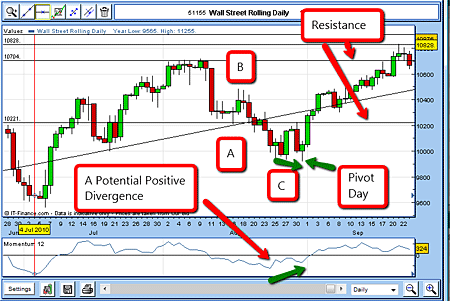How to trade volatile markets without losing your shirt
Since the 6 May 'flash crash' this year, stock markets have been very jittery, with some very wide swings. Here's how to trade them without losing a packet.
Since the 6 May 'flash crash' this year, stock markets have been very jittery. Some investors fear a 1930s-style economic collapse. Others hope for a huge recovery, driven by large corporations starting to spend some of the record levels of cash they're sitting on.
Which outcome is more likely? To be blunt, it doesn't matter. As traders, we can ignore all this.
Of course you'll have a view on the direction of the economy and it's useful as a 'big picture' backdrop to inform your investing and trading goals. But at the same time, it's best not to be dogmatic. After all, the economy is not the same thing as the market. There have been many examples of the stock markets rallying, while the underlying economy weakens (and vice versa).
Subscribe to MoneyWeek
Subscribe to MoneyWeek today and get your first six magazine issues absolutely FREE

Sign up to Money Morning
Don't miss the latest investment and personal finances news, market analysis, plus money-saving tips with our free twice-daily newsletter
Don't miss the latest investment and personal finances news, market analysis, plus money-saving tips with our free twice-daily newsletter
A recent case in point has been the Dow Jones. Since the 6 May crash, markets have seen some very wide swings while the underlying US economy has been weak. But from the low in July at around 9,600, the Dow rallied 1,000 points within just four weeks.
As traders, how do we profit from such moves while still adhering to our 3% rule?
If we go back to late August when the world was coming to an end (or so you'd have believed if you'd been reading the papers), stocks had been falling since their 6 August highs. On 26 August, they were making a new low (see point C):

Momentum was falling, confirming the downtrend. Then, there was a good-sized bounce on 27 August followed by a re-test of the lows on 31 August. If the market was to remain in the downtrend, it had to move lower from there.
Instead, it found support and moved slightly higher. On the very next day (1 September), the market shot up past the previous resistance at the 10,200 level. That confirmed that the low on 31 August was a significant one I call these days 'pivot days', as they mark an unexpected change in trend, accompanied by a positive divergence with momentum (indicated with the red and green arrows above) as confirmation.
Anticipating this, I placed a resting buy-stop order just above the resistance line (indicated above by the red arrow) and placed my protective stop 150 pips lower, as I judged that if the market reached that point, it would indicate that my analysis was wrong (and a high chance for five Elliott waves, as I'll explain in a moment).
The other clue for me was the clear three-wave Elliott pattern (the A-B-C shape marked on the chart) that was forming.
According to Elliott wave principles, three waves signify a counter-trend move against the larger trend (which is up).
If the market had moved lower after 1 September, and made five clear waves, then almost certainly the up-move would be over, and I would suffer a loss. (As a trader, I would then look for a bounce to establish new short positions).
But no, the market followed my first script beautifully.
1 Sept Buy £1 Dow @ 10,250.
Protective stop @ 10,100 for a 150 pip risk (3% of the £5,000 in my account).
Over the next few days, the market rallied and then pulled back but only to the previously-drawn support line. As the market made new highs for the move into September, I raised my stop to break-even, following my break-even rule. Now I have a free ride.
It then seemed to me that the Dow was heading for a challenge of the previous high at 10,720 from early August. The bulls were definitely in charge. But I had seen that the Dow rallies were on low trading volume (not a good sign), and I was still long-term bearish. So I decided not to overstay my welcome. I entered a resting sell limit order just above the 10,720 high. Markets have a tendency to take out stops just above previous highs and then fall back. I didn't have to wait long for the order to be filled. Here is my trade:
20 Sept Sell £1 Dow @ 10,750.
Profit 500 pips (£500) for a risk of £150.
I have a feeling that the bears will eventually win out, but first, many of them must be punished for doing the obvious rarely a good strategy in the financial markets!
John is is a British-born lapsed PhD physicist, who previously worked for Nasa on the Mars exploration team. He is a former commodity trading advisor with the US Commodities Futures Trading Commission, and worked in a boutique futures house in California in the 1980s.
He was a partner in one of the first futures newsletter advisory services, based in Washington DC, specialising in pork bellies and currencies. John is primarily a chart-reading trader, having cut his trading teeth in the days before PCs.
As well as his work in the financial world, he has launched, run and sold several 'real' businesses producing 'real' products.
-
 What is bitcoin halving and what does it mean for crypto investors?
What is bitcoin halving and what does it mean for crypto investors?Bitcoin halving is likely to take place this week, according to experts. Historically, this practice has caused the cryptocurrency to soar in value. But will this time be different?
By Katie Williams Published
-
 British Airways revamps Avios scheme bringing down flight prices to £1
British Airways revamps Avios scheme bringing down flight prices to £1With the new Avios part-payments scheme you can now bag a British Airways flight for as little as £1
By Oojal Dhanjal Published